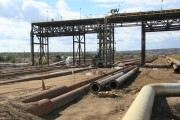There has been a lot of press coverage of ill-gotten gains involving the Ontario Lottery Corporation this winter and spring. Yet the $100 million made off with by unscrupulous lottery retailers pales in comparison to the jackpot hit by Bruce Power when it signed a sweetheart deal to rebuild aging nuclear reactors at the publicly owned Bruce Nuclear Station.
In his report on the deal, released by the provincial government the afternoon before Good Friday, Ontario's auditor general identified some of the obvious winnings: a 44 per cent price premium compared to the average price of electricity in Ontario over the past five years; a poorly explained last-minute $250-million increase in the cost of the 30-year contract; a hefty helping hand from the public purse with capital cost overruns; guaranteed markets for any power produced whether it can be used or not, and the assumption of fuel costs in the context of a 10-fold increase in the price of uranium.
These arrangements are on top of the already generous provisions of the original Bruce facility lease agreement, which absolved Bruce Power of responsibility for waste nuclear fuel management and facility decommissioning, and was premised on the transfer of the billions of dollars in long-term debt associated with the facility to Ontario taxpayers.
There are a number of lessons to be drawn from the extraordinary provisions of the Bruce refurbishment contract so ably highlighted by the auditor general.
The first is that the Bruce Power contract provides a clear indication of the kinds of government-guaranteed profits, and assumptions of risks and liabilities by ratepayers and taxpayers, that are likely to be needed to get private investors to even look at high-cost, high-risk nuclear projects.
Building or refurbishing nuclear plants ties up billions of dollars in capital with no return on investment for years, if not decades. In fact, one of the original partners in the Bruce Power consortium, Cameco Inc. (a company whose major business is uranium mining) declined to participate in the refurbishment project, as it didn't offer sufficient return on investment.
The implications of this in terms of the costs and risks that Ontario electricity ratepayers and taxpayers will be asked to absorb in order to bring in the private capital needed to support the Ontario Power Authority's proposed $40-billion plan for more nuclear plant refurbishments, and even new plant construction, are nothing short of ominous.
The province's first nuclear building boom in the 1970s and 1980s left Ontario taxpayers holding $15 billion in "stranded" nuclear debt from Ontario Hydro, and that was without having to provide market rates of return to private investors.
Secondly, the contract highlights the risks of making multibillion-dollar investment decisions in the context of a perceived "crisis." The Bruce Power deal was negotiated in an atmosphere of near panic over the future of the province's electricity supply, reinforced by the difficulties encountered in meeting periods of extremely high electricity demand during the very hot summer of 2005.
In reality, the province was confronted with two distinct challenges: the need to deal with short-term extreme peaks in electricity demand on very hot summer days; and the longer term choices related to the anticipated end of life of the province's existing coal and nuclear power plants over the next two decades.
The first problem is best dealt with through energy conservation and building high-efficiency natural gas-fired plants that can respond to changes in electricity demand quickly. Rebuilding nuclear plants is largely irrelevant to this issue, as nuclear facilities offer no capacity to vary their output in response to sudden increases in demand.
The second challenge requires major decisions about the structure of our electricity system, but the problem will not become acute until well into the next decade, with the implication that we have time to consider our choices carefully.
Unfortunately, at the time the Bruce Power deal was negotiated, the two issues had become hopelessly confused, with the government feeling driven to make major commitments on coal and nuclear plant replacement immediately, without proper analysis and consideration of alternatives.
Ontario had a choice about signing the Bruce Power deal. It still has choices about whether to repeat the same mistakes again, or to make sure it has fully exploited the potential to dramatically improve Ontario's energy efficiency and the enormous opportunities to develop low-impact renewable energy sources.
We need to know those options have been exhausted before we even contemplate giving out more guaranteed winning tickets to the nuclear industry and guaranteed losses for ratepayers and taxpayers.
Dr. Mark Winfield is director of the Pembina Institute's Environmental Governance Program, based in Toronto.







